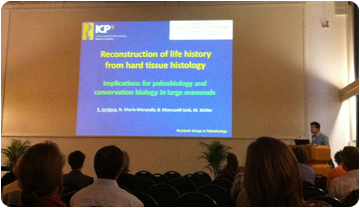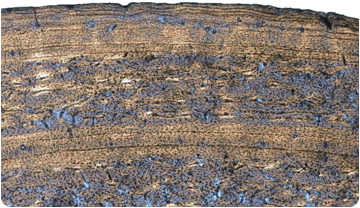
The voices calling to know more and better the fossil record in order to understand what is happening today, and to gather more data on which more efficient environmental policies can be based, are increasingly numerous and clear. This relationship between the past and the present, and especially the future, is a rising area of research.
The Paleobiology Research Group at the ICP is developing highly innovative research lines, which are digging into the evolutionary trends to extinction or adaptation of different mammalian species in front of climate change and other situations with important restrictions of resources, as it is the case of the island ecosystems.
A few days ago one of the researchers of this group, Xavier Jordana, participated in the 86th Annual Conference of the German Society of Mammalogy "The Past, Present and Future of mammalian DIVERSITY". The organizers, a group of geneticists experts in conservation biology at the Senckenberg Research Institute (Natural History Museum Frankfurt) had invited some paleontologists to present their work. No surprise so far, as it is known that paleontology helps us to understand the diversity of extinct species. But the ICP researcher X. Jordana had been invited to present their work in Thursday's session, dedicated to the current aspects of mammalian diversity. To talk, ultimately, of from the knowledge of the life cycles of extant and extinct mammals, we can learn if populations are prepared to deal with present and future environmental changes.

Xavier Jordana during his communication at the Annual Conference of the German Society of Mammology.
Q: Xavier, why do you think you were invited to a conference like this, and especially why was your talk included in the research on modern mammals?
These days there are more and more researchers working on conservation biology of mammals who believe that knowledge of the life histories of animals is a key factor to develop policies for the conservation of endangered species. And what we do in the Paleobiology Research Group at ICP is strongly related to this subject. It means understanding the evolutionary adaptations of the life cycles of mammals from the fossil record. Our group is a pioneer in rebuilding life history and physiological characteristics of fossil mammals. However, we do not want to stay in the study of the past only, but we also want to look for applications to the present and the future. We have recently published an article in the prestigious journal Nature where we show how you can learn about some physiological characteristics and the life histories of modern mammals, characteristics of great importance for survival such as age at first reproduction or longevity, from the internal structure of long bones. This represents an alternative to the usual monitoring programs of wild species, which can have a high cost and require a long time. This new method may, therefore, be useful for the conservation of endangered species.
A few months ago, we wrote in this web about another article published in Nature in which a team of prestigious international researchers were calling for more research to better understand the climate changes suffered by the Earth during millions of years, and thus improve our ability to predict these changes and understand whether human activity may be pushing our planet to irreversible changes in the biosphere.
Q: Xavier, do you think this message has already penetrated in the scientific community? Do scientists agree that paleontology can also provide very important clues for ecological research today?
Yes, in fact it is an emerging field, still very new. Emerging research areas such as Conservation Paleobiology or Historical Ecology go in this direction. A clear example of this recent interest in joint efforts between paleontologists and ecologists is the topic of the latest edition of the Annual Conference of the German Society of Mammalogy: "Past, Present and Future of Mammalian Diversity", in which we were invited to present a communication.
Q: To talk about biodiversity conservation goes beyond discussing about the number of species, right? What can paleontology say about the conservation of biodiversity?
Paleontology can bring many things to the conservation of biodiversity, but the most important information it can bring, which you cannot get from extant species, is knowledge about the long-term adaptive responses of species against environmental changes. This knowledge can help us predict which species are most at risk of extinction in the current conditions of climate change. The fossil record can tell us about the diversity of species in the past. But if, in addition, we put this information in the context of climate changes that have occurred in the last million years, then we can relate the environment to extinctions. And, if we add to all this knowledge about the evolutionary adaptations of these species, such as changes in the life histories, then we can predict evolutionary trends to changes in their ecosystems.

Alpine red deer; slide showing two double rest lines in the inner cortex. Meike Köhler. ICP
Q: Are there many research teams working in this direction?
Not really. There are more and more teams of paleontologists specializing in what is known as conservation paleobiology. But those who study the life history of mammals from the fossil record are very few. In addition to our group, lead by the ICREA researcher Meike Köhler, there is Tim Bromage's group at the University of New York and with less intensity Jorge Cubo’s group at the Pierre and Marie Curie University in Paris. In fact, we have recently been awarded a project by the Ministry of Economy and Competitiveness in Spain to do research all together, in collaboration with other two groups expert in insular systems, and we will continue to explore what the life history of extinct species tells us about the current diversity on Earth.
Q: Meike and you work together, but we could say that she knows better the bones and you the teeth of fossil animals. What is the difference? To what extent do we get complementary information, and to what extent are two different methods that allow us to compare results?
Both bones and teeth are hard tissues and thus they give us a very similar information. However, it can also be complementary. For example, the tooth development pattern in mammals is very conservative, and therefore shows lower plasticity (change capacity) than the skeleton. This makes the dental development a very reliable indicator of the growth of certain ontogenetic stages. As an example, the eruption of the first molar is closely related to the age of weaning, and the third molar with the onset of maturity. However, bone is more sensitive to physiological (internal) and environmental (external) stimuli as evidenced by the momentary arrested growth during the unfavorable season, or the drastic reduction of the bone growth rate coinciding with the age of reproduction . The ideal is to have the information of both bones and teeth, to reconstruct the physiological and developmental aspects of extinct animals.










